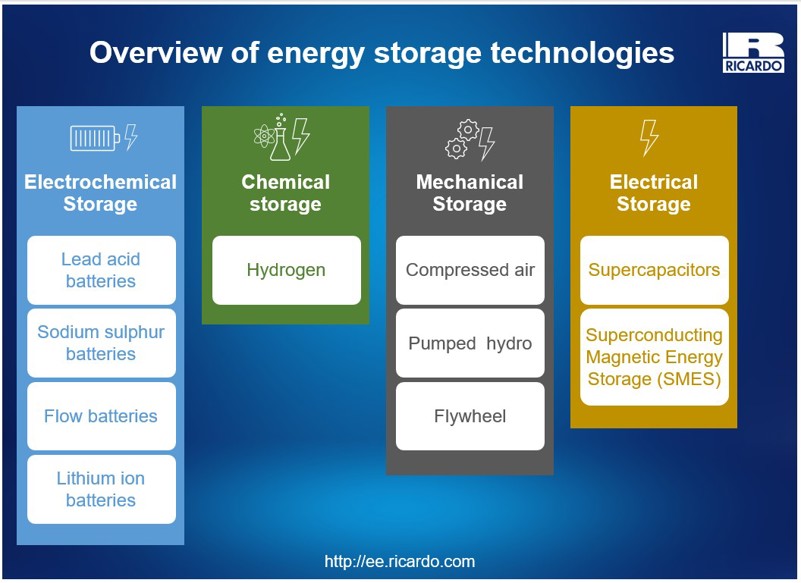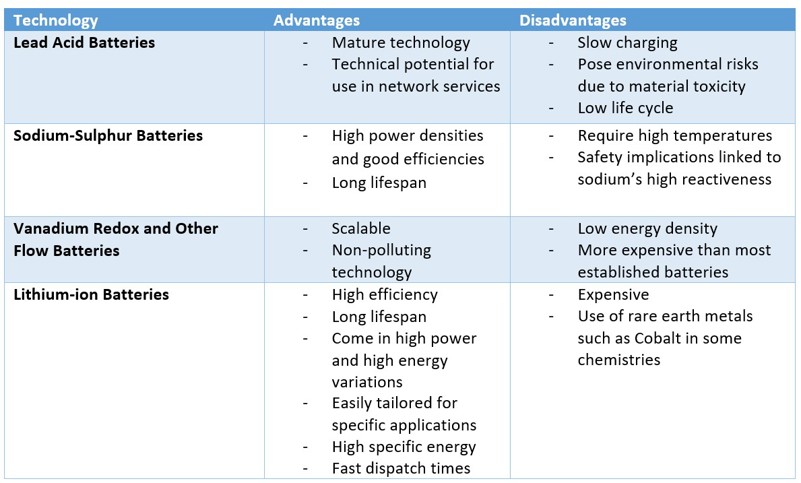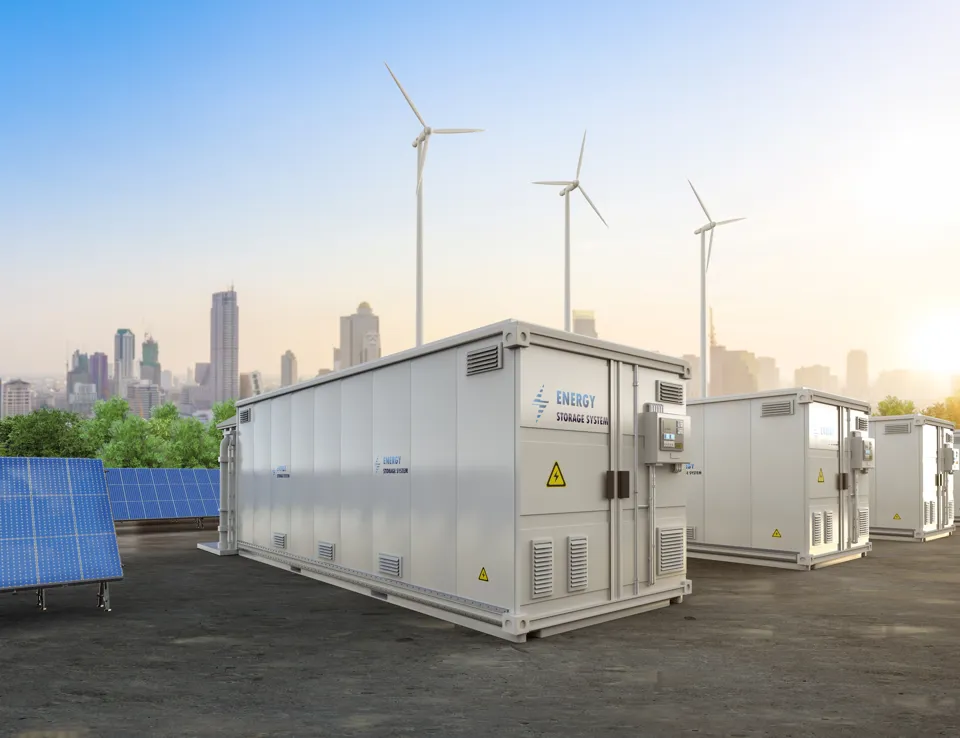An overview of the four main energy storage technologies
Energy storage is the process of capturing produced energy to be used at a later point in time. By doing so, energy storage bridges the mismatch between supply and demand - an issue that is particularly pertinent for the transition to clean energy.
Having sufficient energy is critical to running a business, and having suitable energy storage unlocks three important benefits:
- Increased resilience in the face of energy uncertainty: having temporary continuity and backup in the event of a power outage; critical to keep your business running 24/7.
- Financial savings: by 'load shifting', charging the battery at times when electricity is cheaper e.g., at night, and shifting this stored power to be used during more expensive peak periods.
- Reduced carbon emissions: by being less reliant on non-clean energy from the grid, contributing to national and business decarbonisation targets.
Energy storage has been established for decades and comes in several forms, broadly categorised into electrochemical, chemical, mechanical and electrical.

1. Electrochemical storage
Electrochemical power sources convert chemical energy into electrical energy and batteries fall within that category. Each battery technology comes with varying sets of advantages and disadvantages, and different levels of technological maturity.

Why lithium-ion has emerged as the leading battery technology
Lithium-ion batteries are in wide use as they are so versatile, suitable for applications ranging from small electronics to electric vehicles, and grid connected storage facilities. Their high efficiency and high energy density, combined with long lifetime have been pivotal in enabling the electrification of transport. By virtue of their quick response times, they are the technology of choice for provision of grid services like frequency response.
Flow batteries - for longer discharge durations
Another notable technology is flow batteries, which are making quick strides in their development. Despite their low density, they are an excellent option for stationary applications and can offer a much longer duration than Lithium-ion and still participate in the provision of grid services.
We at Ricardo Energy & Environment have worked on projects that explore batteries as a solution for bridging renewable energy generation and demand, for providing ancillary services and for transport applications such as discontinuous electrification of rail lines served by battery powered trains.
2. Chemical energy storage
Chemical energy storage technologies can take the form of power-to-gas or power-to-liquids and producing hydrogen using renewable energy is currently generating a lot of excitement. In addition to replacing grey hydrogen for industry needs, hydrogen as a storage medium could offer attractive benefits:
- Hydrogen could offer a solution for hard-to-decarbonise sectors such as shipping, aviation and remote railway transport.
- Hydrogen could offer a good solution for long-term storage as storage capacity is scalable.
Green hydrogen is produced through the process of electrolysis. It can be used directly, used to produce other chemicals such as ammonia or converted back to electricity using fuel cells.
We have diverse experience across the hydrogen sector and have carried out studies on the use of hydrogen in hard-to-decarbonise transport applications.
There are multiple other technologies used to store energy that fall into the categories of mechanical, electrical and thermal energy storage.
3. Mechanical energy storage
This includes technologies such as:
- Pumped hydro
A well-established technology that offers many benefits. This technology could meet the needs for frequency control, congestion relief, spinning reserve and black start (see glossary of terms below), and offers excellent performance as a long duration storage option. Pumped hydro installations are often large scale and present geographical constraints for deployment.
- Compressed air energy storage (CAES)
These are commonly large-scale installations with discharge times of several hours. In a typical setup, compressed air will be pumped into an underground salt cavern, and when released, is heated by combusting natural gas before being driven through a turbine. CAES is suitable for bulk energy management and can provide grid services that do not require rapid response times, such as secondary frequency control, load shifting and reserve.
- Flywheels
These are composed of rotating mass that stores kinetic energy. They usually offer high power low energy outputs and provide excellent durability up to 100,000 cycles. Flywheels are well placed for fast frequency response but suffer with high rates of self-discharge.
Glossary of terms:
Frequency control – the process of maintaining stability in a power system
Congestion relief – the management of avoiding periods when transmission lines cannot efficiently transfer power as a result of market demand
Spinning reserve – unloaded generation that rotates in synchronism with the grid
Black start – the restoration of an electrical grid from total or partial shutdown
Load shifting – a management technique where load demand is moved from peak to off-peak periods
Reserve – the storing of energy as a source for additional power
4. Electrical energy storage systems
These are made up of two technologies - supercapacitors, and superconducting magnetic energy storage (SMES).
- Supercapacitors
These have long lifespans, high power density, and a fast response time. The technology is generally reliable and requires minimal maintenance. Despite these positive attributes, one major drawback is their high self-discharge rate.
- Superconducting magnetic energy storage (SMES) systems
These work by storing energy in the magnetic field created by the flow of direct current in a superconducting coil that has been cooled below its critical temperature. SMES boast rapid response times and high efficiency but are large in size and prove costly for their requirement of superconducting materials and cryogenic equipment.
What about storing heat, i.e thermal energy?
Aside from storage technologies that can ultimately produce electricity from the stored energy, thermal energy storage systems can be used store thermal energy and range from simple solutions such as hot water tanks to more sophisticated solutions such as phase changing materials. These solutions can become increasingly popular as we move towards the electrification of heat and the potential proliferation of time-of-use tariffs.
Choosing the best storage option
To more easily visualise the scale of power and storage capacity of these technologies, and provide an initial comparison, we've produced a power/discharge time chart of the different options:

The suitability of a particular storage system for your site or business will vary depending on your energy sources and their cost, as well as the particular characteristics of your site/s.
In addition to the suitability of technology, it is also important to understand the potential economic performance. A thorough assessment of options will enable you to choose the most appropriate technology, have a strong understanding of the potential benefits of the system and ultimately have well-informed investment decisions.
Speak to us for advice on energy storage that best suits your situation
At Ricardo, we are well placed to assess the potential of energy storage for your organisation. Our breadth of technical expertise spans several sectors including energy, waste, food and drink, manufacturing, finance, and transport.
Our energy storage experience enables us to evaluate all available options and identify the most suitable path for your business, as well as providing due diligence and investment screening advice for investors and developers loking to purchase new sites and assets. And to support these decisions, we can also advise you on your eligibility and ease of access to sustainable finance.
So, whether you are just starting to plan your energy transition, or already have a roadmap in place and want expertise to deliver your ambitions, our experts are here to help. Contact us below.









